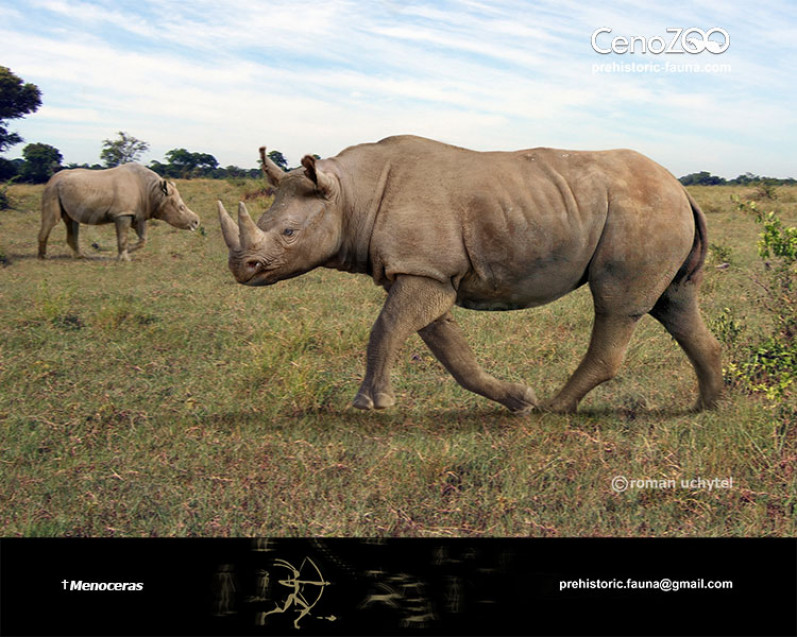Menoceras barbouri
232232Menoceras (Menoceras (Troxell, 1921))
Order: Perissodactyla
Family: Rhinocerotidae
Size: 1.5 m in length, 100-150 cm in height, ~300 kg of weight
Time period: the early Miocene (North America)
Typical representative: Menoceras arikarense
Menoceras ("Crescent Horns") is a genus of extinct, small rhinoceros endemic to most of southern North America and ranged as far south as Panama during the early Miocene epoch. It lived from around 30.7—19.7 Ma, existing for approximately 11 million years. Menoceras roamed across a tropical, savanna-like grassland and plains environment that covered much of North America (Prothero, 2005). Because of the massive accumulations of fossil bones of this animal, particularly at Agate Springs Nebraska, Menoceras may have lived in large herds. However, other sites i.e. Martin-Anthony site Martin County, Florida, and Cady Mountains Horse Quarry, San Bernardino County, California.
Male Menoceras sported two horns side by side at the tip of the nose, whereas the females were hornless. All other rhino genera, save the related genus Diceratherium, have their horns arranged one behind the other. Either gender of Menoceros grew to a length of 1.5 meters long, around the size of a large pig, or a domesticated sheep.
Menoceras was named by Troxell and assigned to Rhinocerotidae by Troxell in 1921. It was synonymized subjectively with Diceratherium by Matthew in 1931 and Wood in 1964. Again assigned to Rhinocerotidae by Prothero, Guerrin, Manning in 1989. Tanner (1969), Wilson and Schiebout (1981), Prothero and Manning (1987), Carroll (1988) and Prothero et al. (1989); and to Menoceratinae by Prothero (1998).
From Wikipedia, the free encyclopedia
Menoceras (Menoceras (Troxell, 1921))
Order: Perissodactyla
Family: Rhinocerotidae
Size: 1.5 m in length, 100-150 cm in height, ~300 kg of weight
Time period: the early Miocene (North America)
Typical representative: Menoceras arikarense
Menoceras ("Crescent Horns") is a genus of extinct, small rhinoceros endemic to most of southern North America and ranged as far south as Panama during the early Miocene epoch. It lived from around 30.7—19.7 Ma, existing for approximately 11 million years. Menoceras roamed across a tropical, savanna-like grassland and plains environment that covered much of North America (Prothero, 2005). Because of the massive accumulations of fossil bones of this animal, particularly at Agate Springs Nebraska, Menoceras may have lived in large herds. However, other sites i.e. Martin-Anthony site Martin County, Florida, and Cady Mountains Horse Quarry, San Bernardino County, California.
Male Menoceras sported two horns side by side at the tip of the nose, whereas the females were hornless. All other rhino genera, save the related genus Diceratherium, have their horns arranged one behind the other. Either gender of Menoceros grew to a length of 1.5 meters long, around the size of a large pig, or a domesticated sheep.
Menoceras was named by Troxell and assigned to Rhinocerotidae by Troxell in 1921. It was synonymized subjectively with Diceratherium by Matthew in 1931 and Wood in 1964. Again assigned to Rhinocerotidae by Prothero, Guerrin, Manning in 1989. Tanner (1969), Wilson and Schiebout (1981), Prothero and Manning (1987), Carroll (1988) and Prothero et al. (1989); and to Menoceratinae by Prothero (1998).
From Wikipedia, the free encyclopedia


-797x638.jpg)


-70x56.jpg)

-346x277.jpg)
-346x277.jpg)